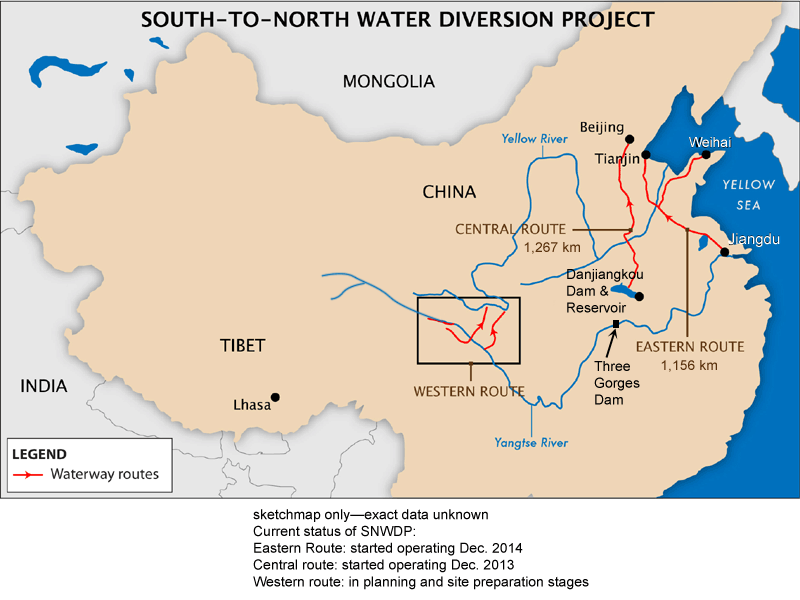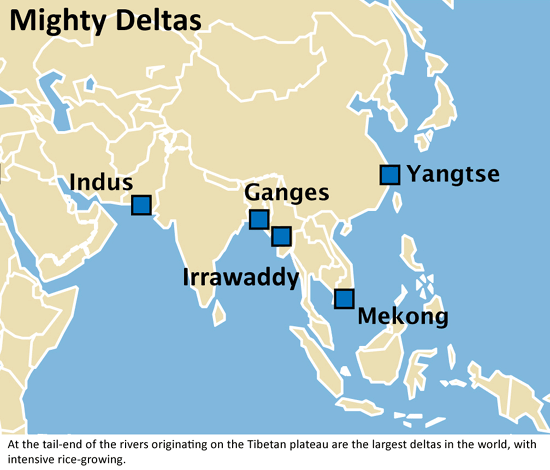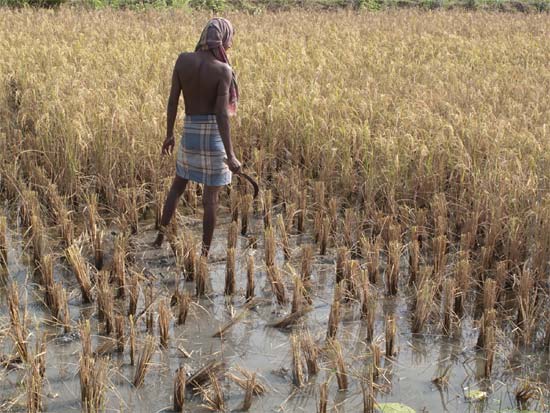BLOG
December 1st, 2011
Via Meltdown in Tibet, some interesting comments and charts on hydropower development on the Tibetan Plateau:
“The world is facing a massive freshwater crisis, which has the potential to be every bit as devastating as climate change. We need business leaders and governments to recognise that climate change is not the only urgent environmental issue that needs to be dealt with, and that they need to take notice of this freshwater emergency and act now, not later.”
—Dr David Tickner, head of the freshwater programme at WWF-UKOn the drawing board, at the edge of the Tibetan Plateau, is a massive water diversion project. The Western sector of the South-to-North Water Diversion Scheme involves the building of three mega-dams (with wall heights of 175 metres, 302 metres and 292 metres) and a system of tunnels stretching some 300 kilometres. This would be designed to divert water uphill from the Yangtse river headwaters to the Yellow River headwaters.
The Western Route actually comprises several routes, taking water from the Yalung, Dadu and upper Yangtse rivers (in Qinghai and Sichuan) across mountains and directing it into the Yellow River. Which would then carry it across North China. Work on this route is in planning stages. The project may take 30 years or more to complete.
A water diversion project of this magnitude has never before been attempted in recorded history. It qualifies as the largest hydro project ever undertaken. What are the possible consequences of such a colossal hydro project? What is the fallout from stealing a river like this?
If you’ve never heard of this Tibet Water Diversion project, you have lots of company. There are over a billion Chinese who are completely in the dark about it too. Seems like Chinese authorities and the engineering planners have neglected to give any specific details to the media. The Water Resources Minister did, however, offer the following comments (from a Hong Kong-sourced report, dated October 2006):
Official Says Tibet Water Diversion Not Feasible
A controversial scheme to channel water from Tibet to the parched Yellow River in western China is unnecessary and anyway not feasible, China’s top water resources minister stated. The proposed system of tunnels stretching 300 km (190 miles), and costing more than the $25 billion Three Gorges Dam hydroelectric mega-project, has the potential to be one of modern China’s most technically challenging feats.
The project is reportedly backed by President Hu Jintao. But Water Resources Minister Wang Shucheng voiced deep reservations about the huge undertaking. “In terms of today’s scheme to develop the west, I will say three things: it is unnecessary, not feasible and unscientific,” said Wang, giving what he called his personal “academic” opinion to an audience of scholars at the University of Hong Kong.
The so-called Western route of China’s South-North Water Transfer Project would involve harnessing rivers cascading from the Tibetan highlands in the Himalayas to quench the thirst of Qinghai province and other poor western areas. “With regard to this Western water transfer route, of all the experts that I know, not one endorses this plan,” he added. Wang stressed that the government had yet to take a decision.
More than 600 medium- and large-sized cities in China were now suffering “serious water shortages”, said Wang, given more than a decade of near double-digit economic growth, droughts, and an expanding population. Wang said the cost of transferring water from Tibet to the Yellow River could amount to 20 yuan ($2.5) per cubic metre, which is much higher than the 3 yuan per cubic metre it would cost to conserve water using various technologies. “From a financial perspective, it’s essentially not feasible,” he said.
Enormous Implications
Here’s a quote from expert Kenneth Pomeranz, from the University of California (writing in Asia-Pacific Journal, July 2009) on this planned massive water diversion project:
“The western route poses by far the biggest complications. It is here that the engineering challenges are most complex and the solutions most untested. It is here (and nearby Yunnan) that the needs of agrarian and industrial China collide most directly with the lives of Tibetans, Yi, Miao, and other minority groups. It is here that the environmental risks of dam building become major international issues, with enormous implications for the Mekong, Salween, Brahmaputra and other rivers relied on by hundreds of millions of South and Southeast Asians. And it is here that major water projects—which always include many uncertainties—collide with what has always been an extraordinarily fragile environment, and one which now faces far more than the average amount of uncertainty from climate change: Tibet, home to by far the largest number of glaciers outside the two polar regions, is expected to warm at twice the global rate during the 21st century.”
east-west water diversion scheme
Meanwhile, on the east coast, another harebrained scheme to move seawater west, to the parched desert terrain of Xinjiang. This proposal aims to hydrate Xinjiang by pumping seawater 2,000 kilometres inland and 1,200 metres uphill from the Bohai Sea. Massive water desalination plants are also planned on China’s east coast:
The summit’s basic ideas on the subject of “Moving Seawater West; Bringing Bohai to Xinjiang†were as follows: At the northwest shore of the Bohai Sea, raise the seawater to a height of 1,200 metres above sea level and send it to the southeast part of Inner Mongolia Autonomous Region. From there, skirt the foothills of the Mazong mountains and enter Xinjiang. The tentative plan is intended to fill salt flats, saltwater lakes, and structural basins with large quantities of seawater to form man-made seawater rivers and lakes, thereby suppressing the desert. At the same time, a large quantity of seawater will naturally evaporate under the abundant sunlight of the northwest, becoming moist air that will humidify the northern climate and provide a source of increased rainfall, thereby achieving the goals of controlling the country’s deserts and dust storms and completely transforming the poor ecological environment of the northern and western regions.
MIGHTY DELTAS
At the tail-end of the rivers source in Tibet lie the biggest deltas in the world, where water is consumed in large quantities—particularly for the growing of rice. These are the rice-baskets of Asia:
- The Indus Delta—major agricultural zone for Pakistan
- The Ganges/Brahmaputra Delta—agricultural heartlands of India and Bangladesh
- the Irrawaddy Delta—major rice producer for Burma
- The Mekong Delta—major rice producer for Vietnam
- Yangtse River Delta—intensive rice growing and inland fishing region close to Shanghai
Most of the world’s rice is grown and consumed in Asia. It takes 250 to 600 gallons of water to grow a pound of rice. Or in metric terms, around 2,000 to 4,500 litres of water to grow a kilo of rice.

WHERE WILL THE WATER COME FROM?
Demand for water for agricultural use in Asia expected to skyrocket
A UN report presented in Stockholm, Sweden, on August 17, 2009, predicts that demand for food and feed in Asia will double by the year 2050. That estimate does not take into account the possible impact of global warming on water supplies, nor the impact of dams. Asia’s population is forecast to increase by 1.5 billion people over the next 40 years.
Scientists have warned Asian countries that they face chronic food shortages and likely social unrest if they do not improve water management. The water experts at a UN-sponsored conference in Sweden say countries in south and east Asia must spend billions of dollars to improve antiquated crop irrigation to cope with rapid population increases. The findings are published in a new joint report by the UN Food and Agricultural Organisation and the International Water Management Institute (IWMI). They suggest that Asian countries will need to import more than a quarter of their rice and other staples to feed their populations.
“Asia’s food and feed demand is expected to double by 2050,” said IWMI director general Colin Chartres. “Relying on trade to meet a large part of this demand will impose a huge and politically untenable burden on the economies of many developing countries.
“The best bet for Asia lies in revitalising its vast irrigation systems, which account for 70% of the world’s total irrigated land,” he said. With new agricultural land in short supply, the solution, he said, is to intensify irrigation methods, modernising old systems built in the 1970s and 1980s. But that, he says will require billions of dollars of investment.
‘Scary scenarios’
At the same time as needing to import more food, the prices of those cereals are likely to continue to rise due to increasingly volatile international markets. The report says millions of farmers have taken the responsibility for irrigation into their own hands, mainly using out-of-date and inefficient pump technology. This means they can extract as much water as they like from their land, draining a precious natural resource.“Governments’ inability to regulate this practice is giving rise to scary scenarios of groundwater over-exploitation, which could lead to regional food crises and widespread social unrest,” said the IWMI’s Tushaar Shah, a co-author of the report. Asian governments must join with the private sector to invest in modern, and more efficient methods of using water, the study concluded. “Without water productivity gains, south Asia would need 57% more water for irrigated agriculture and east Asia 70% more,” the study found. “Given the scarcity of land and water, and growing water needs for cities, such a scenario is untenable,” it said. The scenarios forecast do not factor in the impact of global warming, which will likely make rainfall more erratic and less plentiful in some agricultural regions over the coming decades.






